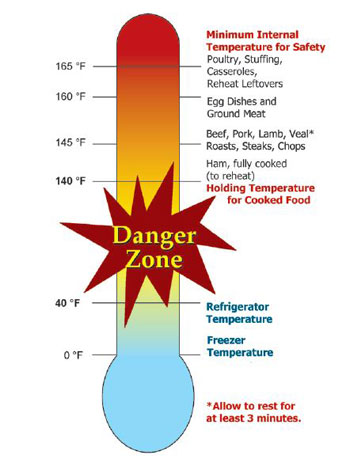Food Temperatures for Any Type of Cooking
Food temperatures are very important to understand when you are the cook. Every meat has a different inner temperature that should be reached in order to ensure bacteria, viruses, and germs are killed on the food while you cook. You don't want to poison anyone with improperly cooked meat, now do you?

Cooking meat can be very tricky, and like most people, when I first started out cooking, I liked to wing it and cook it until it looked done. But looks can be very deceiving, especially with poor lighting or if the meat was frozen when you started.
Memorizing all of the cooking temperatures is one way to remember, but when you don't cook a particular type of meat in a while, you tend to forget or mix it up with another type of meat. And when you are doing all of the work preparing and cooking the food, it can sometimes slip your mind.
You want to be sure before you serve cooked meat to your family or your guests.
What's the Danger of Undercooked or Improperly Prepared Foods?
Bacteria like salmonella, E. coli, and listeria are odorless, tasteless, and invisible to normal human sight. Different bacterias and germs is destroyed at certain temperatures. Simply tasting something that isn't done cooking all of the way can cause some serious health problems for you or your family members.
Here are Some of the Things that Can Cause Food Poisoning:
1. Parasites are microscopic organisms that live on animals as part of their normal lives.
2. Viruses and Bacteria can be found on pretty much everything, living and dead. They are generally the most common cause of food borne poisoning.
3. Mold can cause some ill effects when consumed. Besides mold, there are other contaminants that can be toxic when consumed.
4. There are many allergens out there that are associated with different types of foods. These are worse than bacteria and parasites because you can't cook an allergen out of the food.
When preparing your meal, make sure nobody is allergic to whatever you are using for ingredients. Carefully wash all vegetables and meat by soaking in cool water just before use. Then follow the temperature guide below to ensure your food is cooked at the right temperature for safe consumption.
Safe Food Temperatures for Cooking
The following list of food temperatures is derived from Foodsafety.gov and other reputable sources. All temperatures are in Fahrenheit.
Click the Food Temperatures Chart from Foodsafety.gov to view or download a tabular format of the foods and associated cooking temperatures.
1. Ground Meat or Meat Mixtures of beef, pork, veal, and lamb should be cooked to 160 degrees with no rest time required.
2. Ground Meat or Meat Mixtures of turkey or chicken should be cooked to 165 degrees with no rest time after removal from heat.
3. Fresh beef, veal, or lamb steaks, roasts, or chops should be cooked to 145 degrees and set to rest off of the heat for three minutes (where temperature should rise slightly more).
4. Poultry or poultry containing foods (chicken, turkey, duck, goose, pheasant, grouse, and other birds) such as whole birds, pieces, or stuffing should be cooked to 165 degrees with no rest time required.
5. Fresh pork and ham should be cooked to 145 degrees and should sit for 3 minutes rest after removing from heat.
6. Precooked ham should be reheated to 140 degrees with no rest time.
7. Eggs should be cooked to 145 degrees until the yolk and white is firm. No rest time required.
8. Egg dishes should be cooked to 160 degrees with no rest time.
9. Microwave, Leftover and Casserole type foods should be cooked to 165 degrees with no rest required.
10. Finned type fish should be cooked to 145 or until flesh is opaque and separates easily with a utensil.
11. Shrimp, lobster and crab should be cooked until flesh is pearly and opaque.
12. Shell fish such as clams, oysters and mussels should be cooked until their shells open during cooking.
13. Scallops should be cooked until their flesh is milky white or opaque and firm.
14. Fruits and vegetables should be cooked to 135 degrees with no rest time.
Again, the above list was derived from FoodSafety.gov and other sources. These temperatures have been proven to destroy harmful bacteria, germs, and viruses and should be followed for every method of cooking you use.
Be sure to download Foodsafety.gov's safe minimum cooking temperature chart to post on your refrigerator or the wall behind your stove for quick reference.
The importance of food temperatures works hand in hand with preparation and handling of foods once cooked. Be sure to familiarize yourself with the different safety precautions with handling foods, storing foods, and properly preparing foods.